Analysis of Relationship: Enterprise Culture, Creativity, Innovation
VerifiedAdded on 2022/12/26
|8
|2353
|72
Essay
AI Summary
This essay examines the intricate relationship between enterprise culture, creativity, and innovation within an organizational context, using Tesco as a case study. It begins by defining these three core concepts and then appraises the role of creativity, innovation, and enterprise within organizations, highlighting how they contribute to competitive advantage and business success. The main body of the essay delves into the importance of the relationship between enterprise culture, creativity, and innovation, emphasizing the significance of fostering a culture that encourages innovation and creative thinking among employees. The essay explores how leadership, incentives, and organizational structure can influence creativity and innovation. It further analyzes how a strong enterprise culture can promote company growth, encourage positive changes, and enhance the pool of ideas, ultimately leading to a stronger market position. The essay concludes by summarizing the key arguments and reiterating the critical role of the interplay between enterprise culture, creativity, and innovation in driving organizational performance. The essay references academic journals and books to support its analysis.
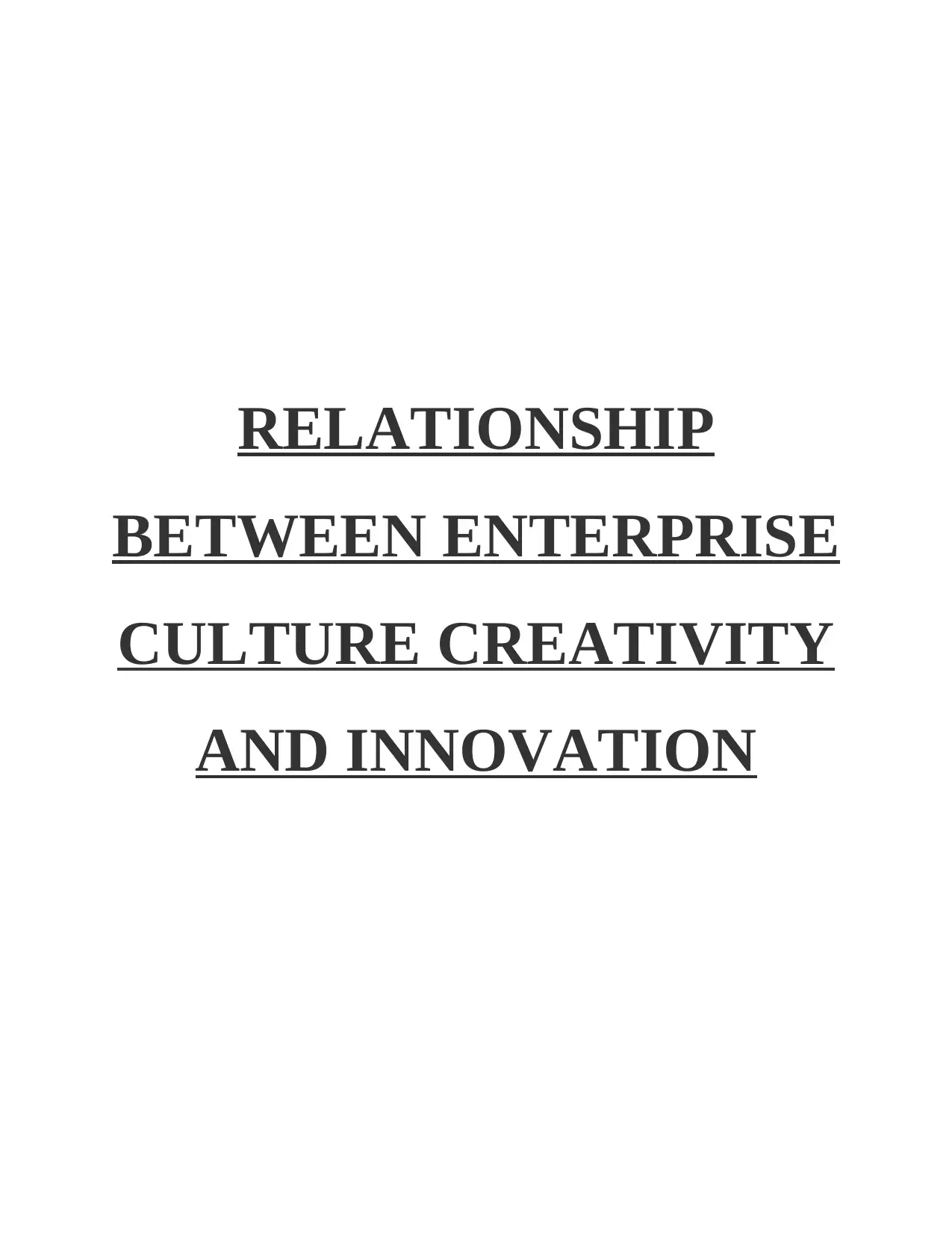
RELATIONSHIP
BETWEEN ENTERPRISE
CULTURE CREATIVITY
AND INNOVATION
BETWEEN ENTERPRISE
CULTURE CREATIVITY
AND INNOVATION
Paraphrase This Document
Need a fresh take? Get an instant paraphrase of this document with our AI Paraphraser
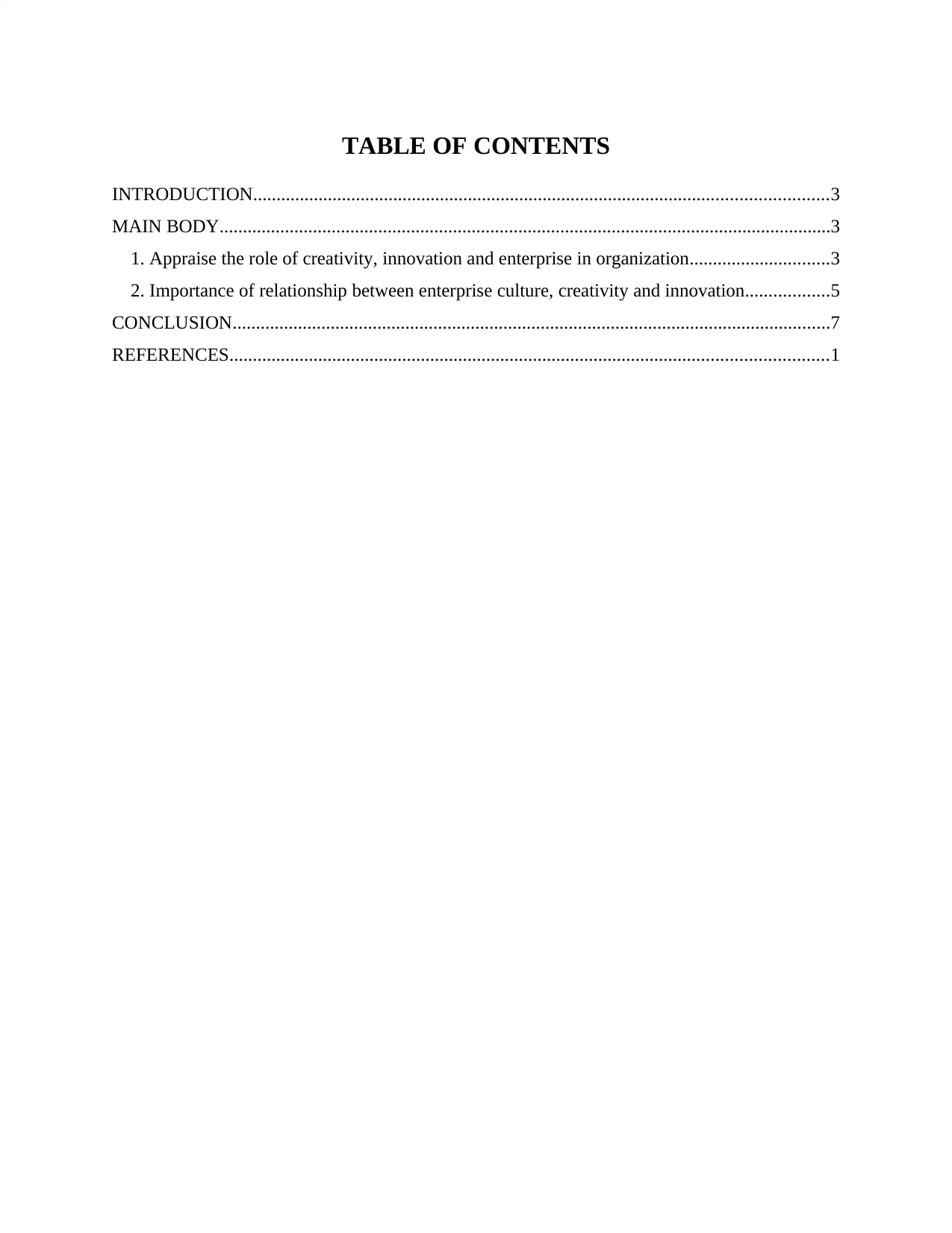
TABLE OF CONTENTS
INTRODUCTION...........................................................................................................................3
MAIN BODY...................................................................................................................................3
1. Appraise the role of creativity, innovation and enterprise in organization..............................3
2. Importance of relationship between enterprise culture, creativity and innovation..................5
CONCLUSION................................................................................................................................7
REFERENCES................................................................................................................................1
INTRODUCTION...........................................................................................................................3
MAIN BODY...................................................................................................................................3
1. Appraise the role of creativity, innovation and enterprise in organization..............................3
2. Importance of relationship between enterprise culture, creativity and innovation..................5
CONCLUSION................................................................................................................................7
REFERENCES................................................................................................................................1
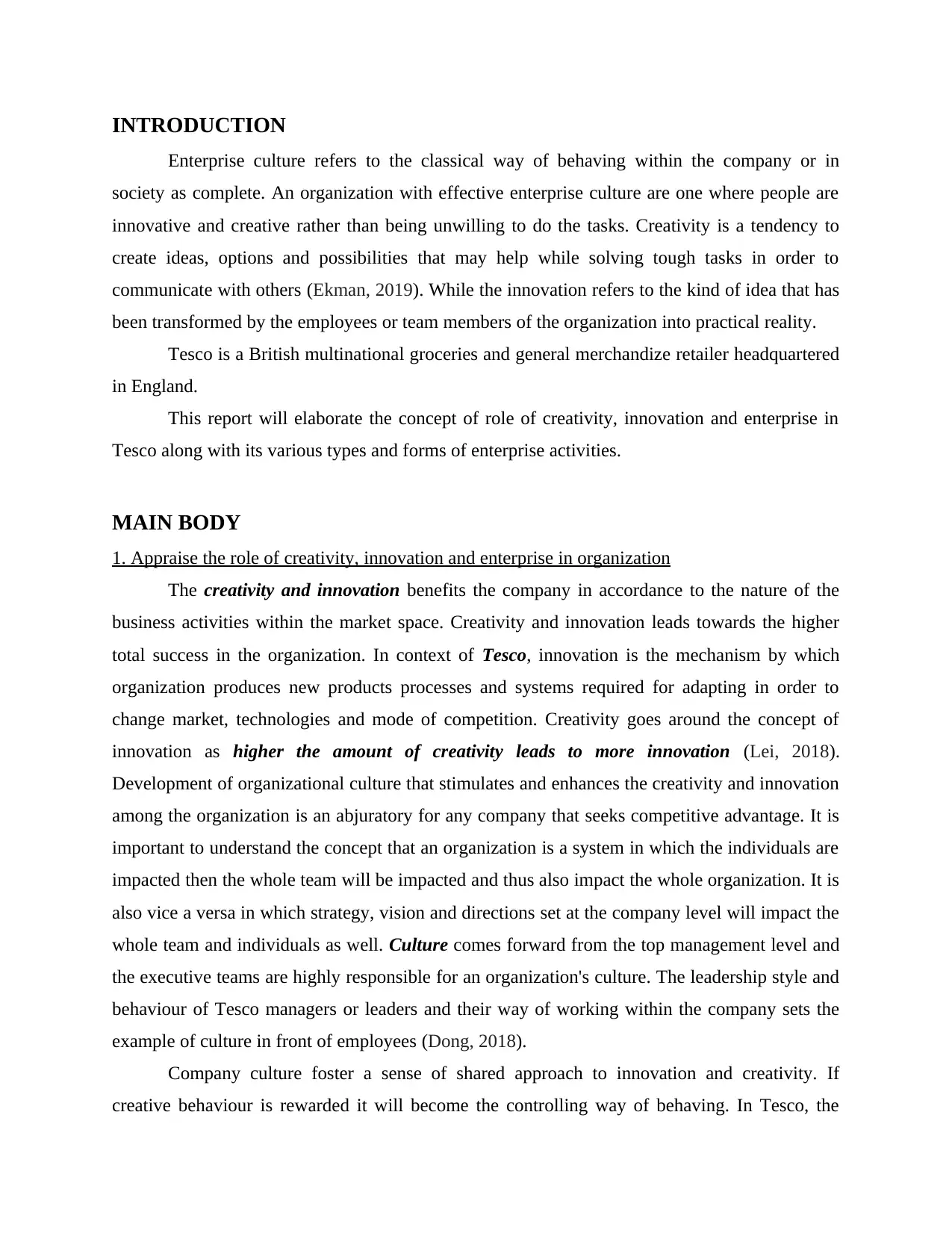
INTRODUCTION
Enterprise culture refers to the classical way of behaving within the company or in
society as complete. An organization with effective enterprise culture are one where people are
innovative and creative rather than being unwilling to do the tasks. Creativity is a tendency to
create ideas, options and possibilities that may help while solving tough tasks in order to
communicate with others (Ekman, 2019). While the innovation refers to the kind of idea that has
been transformed by the employees or team members of the organization into practical reality.
Tesco is a British multinational groceries and general merchandize retailer headquartered
in England.
This report will elaborate the concept of role of creativity, innovation and enterprise in
Tesco along with its various types and forms of enterprise activities.
MAIN BODY
1. Appraise the role of creativity, innovation and enterprise in organization
The creativity and innovation benefits the company in accordance to the nature of the
business activities within the market space. Creativity and innovation leads towards the higher
total success in the organization. In context of Tesco, innovation is the mechanism by which
organization produces new products processes and systems required for adapting in order to
change market, technologies and mode of competition. Creativity goes around the concept of
innovation as higher the amount of creativity leads to more innovation (Lei, 2018).
Development of organizational culture that stimulates and enhances the creativity and innovation
among the organization is an abjuratory for any company that seeks competitive advantage. It is
important to understand the concept that an organization is a system in which the individuals are
impacted then the whole team will be impacted and thus also impact the whole organization. It is
also vice a versa in which strategy, vision and directions set at the company level will impact the
whole team and individuals as well. Culture comes forward from the top management level and
the executive teams are highly responsible for an organization's culture. The leadership style and
behaviour of Tesco managers or leaders and their way of working within the company sets the
example of culture in front of employees (Dong, 2018).
Company culture foster a sense of shared approach to innovation and creativity. If
creative behaviour is rewarded it will become the controlling way of behaving. In Tesco, the
Enterprise culture refers to the classical way of behaving within the company or in
society as complete. An organization with effective enterprise culture are one where people are
innovative and creative rather than being unwilling to do the tasks. Creativity is a tendency to
create ideas, options and possibilities that may help while solving tough tasks in order to
communicate with others (Ekman, 2019). While the innovation refers to the kind of idea that has
been transformed by the employees or team members of the organization into practical reality.
Tesco is a British multinational groceries and general merchandize retailer headquartered
in England.
This report will elaborate the concept of role of creativity, innovation and enterprise in
Tesco along with its various types and forms of enterprise activities.
MAIN BODY
1. Appraise the role of creativity, innovation and enterprise in organization
The creativity and innovation benefits the company in accordance to the nature of the
business activities within the market space. Creativity and innovation leads towards the higher
total success in the organization. In context of Tesco, innovation is the mechanism by which
organization produces new products processes and systems required for adapting in order to
change market, technologies and mode of competition. Creativity goes around the concept of
innovation as higher the amount of creativity leads to more innovation (Lei, 2018).
Development of organizational culture that stimulates and enhances the creativity and innovation
among the organization is an abjuratory for any company that seeks competitive advantage. It is
important to understand the concept that an organization is a system in which the individuals are
impacted then the whole team will be impacted and thus also impact the whole organization. It is
also vice a versa in which strategy, vision and directions set at the company level will impact the
whole team and individuals as well. Culture comes forward from the top management level and
the executive teams are highly responsible for an organization's culture. The leadership style and
behaviour of Tesco managers or leaders and their way of working within the company sets the
example of culture in front of employees (Dong, 2018).
Company culture foster a sense of shared approach to innovation and creativity. If
creative behaviour is rewarded it will become the controlling way of behaving. In Tesco, the
⊘ This is a preview!⊘
Do you want full access?
Subscribe today to unlock all pages.

Trusted by 1+ million students worldwide
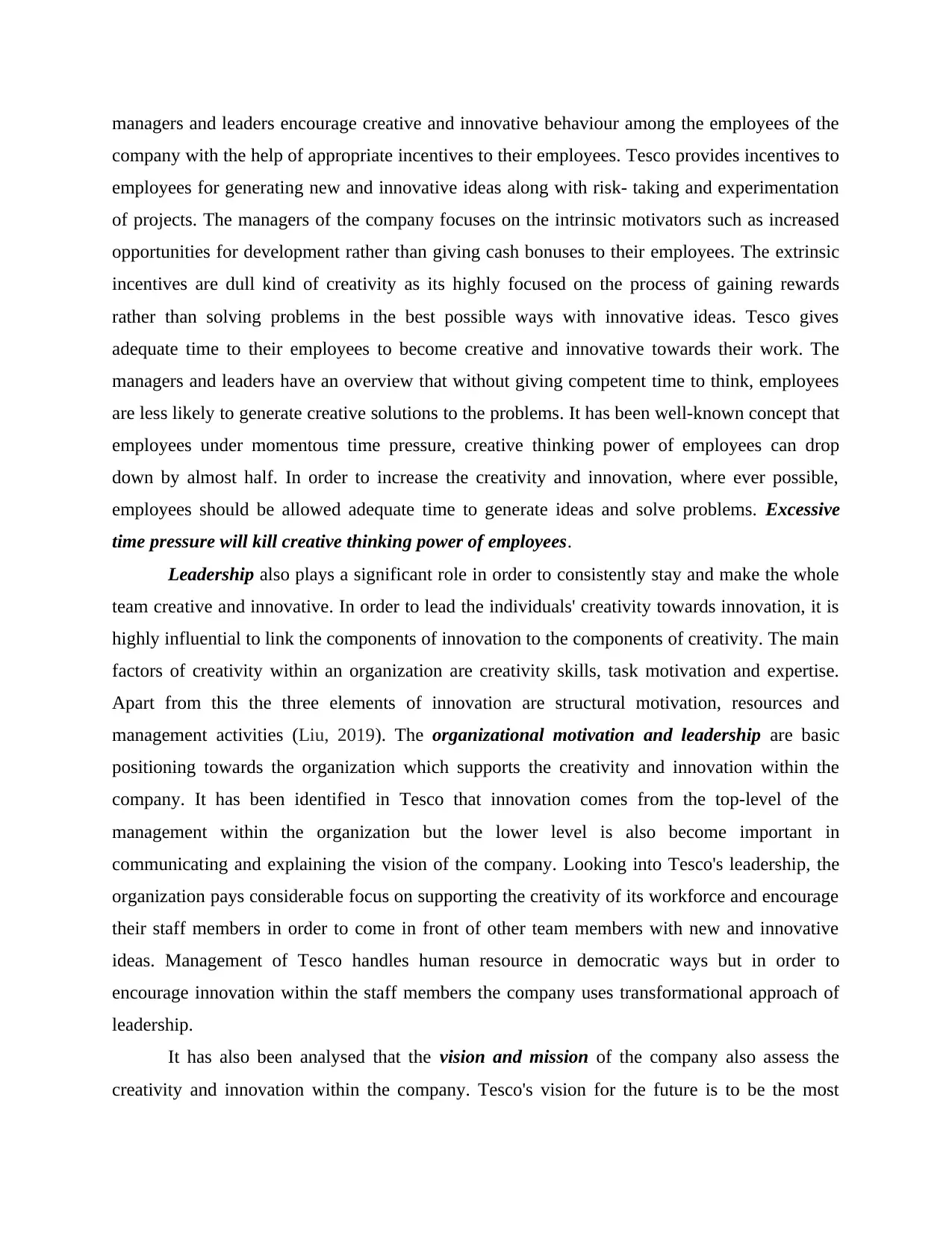
managers and leaders encourage creative and innovative behaviour among the employees of the
company with the help of appropriate incentives to their employees. Tesco provides incentives to
employees for generating new and innovative ideas along with risk- taking and experimentation
of projects. The managers of the company focuses on the intrinsic motivators such as increased
opportunities for development rather than giving cash bonuses to their employees. The extrinsic
incentives are dull kind of creativity as its highly focused on the process of gaining rewards
rather than solving problems in the best possible ways with innovative ideas. Tesco gives
adequate time to their employees to become creative and innovative towards their work. The
managers and leaders have an overview that without giving competent time to think, employees
are less likely to generate creative solutions to the problems. It has been well-known concept that
employees under momentous time pressure, creative thinking power of employees can drop
down by almost half. In order to increase the creativity and innovation, where ever possible,
employees should be allowed adequate time to generate ideas and solve problems. Excessive
time pressure will kill creative thinking power of employees.
Leadership also plays a significant role in order to consistently stay and make the whole
team creative and innovative. In order to lead the individuals' creativity towards innovation, it is
highly influential to link the components of innovation to the components of creativity. The main
factors of creativity within an organization are creativity skills, task motivation and expertise.
Apart from this the three elements of innovation are structural motivation, resources and
management activities (Liu, 2019). The organizational motivation and leadership are basic
positioning towards the organization which supports the creativity and innovation within the
company. It has been identified in Tesco that innovation comes from the top-level of the
management within the organization but the lower level is also become important in
communicating and explaining the vision of the company. Looking into Tesco's leadership, the
organization pays considerable focus on supporting the creativity of its workforce and encourage
their staff members in order to come in front of other team members with new and innovative
ideas. Management of Tesco handles human resource in democratic ways but in order to
encourage innovation within the staff members the company uses transformational approach of
leadership.
It has also been analysed that the vision and mission of the company also assess the
creativity and innovation within the company. Tesco's vision for the future is to be the most
company with the help of appropriate incentives to their employees. Tesco provides incentives to
employees for generating new and innovative ideas along with risk- taking and experimentation
of projects. The managers of the company focuses on the intrinsic motivators such as increased
opportunities for development rather than giving cash bonuses to their employees. The extrinsic
incentives are dull kind of creativity as its highly focused on the process of gaining rewards
rather than solving problems in the best possible ways with innovative ideas. Tesco gives
adequate time to their employees to become creative and innovative towards their work. The
managers and leaders have an overview that without giving competent time to think, employees
are less likely to generate creative solutions to the problems. It has been well-known concept that
employees under momentous time pressure, creative thinking power of employees can drop
down by almost half. In order to increase the creativity and innovation, where ever possible,
employees should be allowed adequate time to generate ideas and solve problems. Excessive
time pressure will kill creative thinking power of employees.
Leadership also plays a significant role in order to consistently stay and make the whole
team creative and innovative. In order to lead the individuals' creativity towards innovation, it is
highly influential to link the components of innovation to the components of creativity. The main
factors of creativity within an organization are creativity skills, task motivation and expertise.
Apart from this the three elements of innovation are structural motivation, resources and
management activities (Liu, 2019). The organizational motivation and leadership are basic
positioning towards the organization which supports the creativity and innovation within the
company. It has been identified in Tesco that innovation comes from the top-level of the
management within the organization but the lower level is also become important in
communicating and explaining the vision of the company. Looking into Tesco's leadership, the
organization pays considerable focus on supporting the creativity of its workforce and encourage
their staff members in order to come in front of other team members with new and innovative
ideas. Management of Tesco handles human resource in democratic ways but in order to
encourage innovation within the staff members the company uses transformational approach of
leadership.
It has also been analysed that the vision and mission of the company also assess the
creativity and innovation within the company. Tesco's vision for the future is to be the most
Paraphrase This Document
Need a fresh take? Get an instant paraphrase of this document with our AI Paraphraser
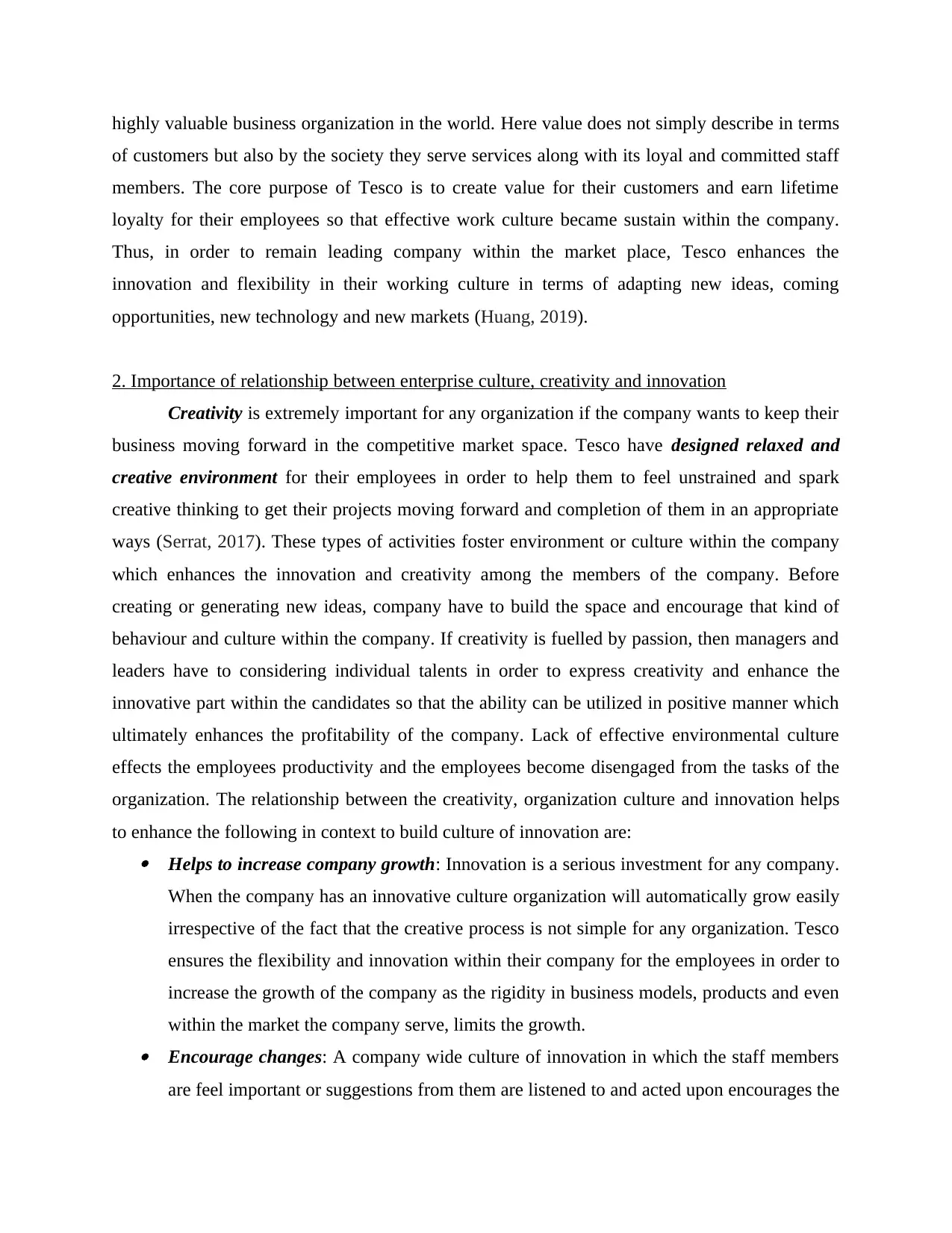
highly valuable business organization in the world. Here value does not simply describe in terms
of customers but also by the society they serve services along with its loyal and committed staff
members. The core purpose of Tesco is to create value for their customers and earn lifetime
loyalty for their employees so that effective work culture became sustain within the company.
Thus, in order to remain leading company within the market place, Tesco enhances the
innovation and flexibility in their working culture in terms of adapting new ideas, coming
opportunities, new technology and new markets (Huang, 2019).
2. Importance of relationship between enterprise culture, creativity and innovation
Creativity is extremely important for any organization if the company wants to keep their
business moving forward in the competitive market space. Tesco have designed relaxed and
creative environment for their employees in order to help them to feel unstrained and spark
creative thinking to get their projects moving forward and completion of them in an appropriate
ways (Serrat, 2017). These types of activities foster environment or culture within the company
which enhances the innovation and creativity among the members of the company. Before
creating or generating new ideas, company have to build the space and encourage that kind of
behaviour and culture within the company. If creativity is fuelled by passion, then managers and
leaders have to considering individual talents in order to express creativity and enhance the
innovative part within the candidates so that the ability can be utilized in positive manner which
ultimately enhances the profitability of the company. Lack of effective environmental culture
effects the employees productivity and the employees become disengaged from the tasks of the
organization. The relationship between the creativity, organization culture and innovation helps
to enhance the following in context to build culture of innovation are: Helps to increase company growth: Innovation is a serious investment for any company.
When the company has an innovative culture organization will automatically grow easily
irrespective of the fact that the creative process is not simple for any organization. Tesco
ensures the flexibility and innovation within their company for the employees in order to
increase the growth of the company as the rigidity in business models, products and even
within the market the company serve, limits the growth. Encourage changes: A company wide culture of innovation in which the staff members
are feel important or suggestions from them are listened to and acted upon encourages the
of customers but also by the society they serve services along with its loyal and committed staff
members. The core purpose of Tesco is to create value for their customers and earn lifetime
loyalty for their employees so that effective work culture became sustain within the company.
Thus, in order to remain leading company within the market place, Tesco enhances the
innovation and flexibility in their working culture in terms of adapting new ideas, coming
opportunities, new technology and new markets (Huang, 2019).
2. Importance of relationship between enterprise culture, creativity and innovation
Creativity is extremely important for any organization if the company wants to keep their
business moving forward in the competitive market space. Tesco have designed relaxed and
creative environment for their employees in order to help them to feel unstrained and spark
creative thinking to get their projects moving forward and completion of them in an appropriate
ways (Serrat, 2017). These types of activities foster environment or culture within the company
which enhances the innovation and creativity among the members of the company. Before
creating or generating new ideas, company have to build the space and encourage that kind of
behaviour and culture within the company. If creativity is fuelled by passion, then managers and
leaders have to considering individual talents in order to express creativity and enhance the
innovative part within the candidates so that the ability can be utilized in positive manner which
ultimately enhances the profitability of the company. Lack of effective environmental culture
effects the employees productivity and the employees become disengaged from the tasks of the
organization. The relationship between the creativity, organization culture and innovation helps
to enhance the following in context to build culture of innovation are: Helps to increase company growth: Innovation is a serious investment for any company.
When the company has an innovative culture organization will automatically grow easily
irrespective of the fact that the creative process is not simple for any organization. Tesco
ensures the flexibility and innovation within their company for the employees in order to
increase the growth of the company as the rigidity in business models, products and even
within the market the company serve, limits the growth. Encourage changes: A company wide culture of innovation in which the staff members
are feel important or suggestions from them are listened to and acted upon encourages the
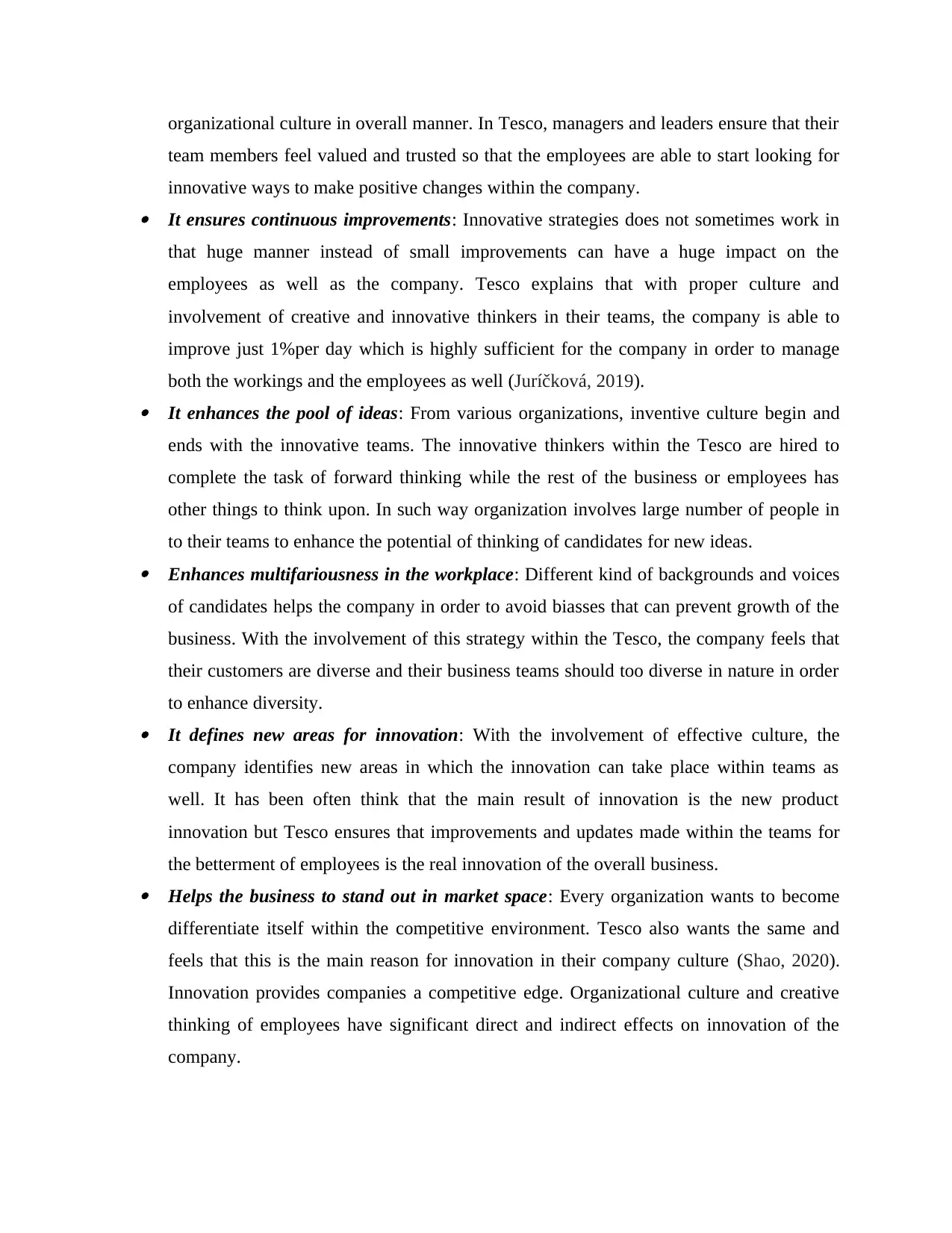
organizational culture in overall manner. In Tesco, managers and leaders ensure that their
team members feel valued and trusted so that the employees are able to start looking for
innovative ways to make positive changes within the company. It ensures continuous improvements: Innovative strategies does not sometimes work in
that huge manner instead of small improvements can have a huge impact on the
employees as well as the company. Tesco explains that with proper culture and
involvement of creative and innovative thinkers in their teams, the company is able to
improve just 1%per day which is highly sufficient for the company in order to manage
both the workings and the employees as well (Juríčková, 2019). It enhances the pool of ideas: From various organizations, inventive culture begin and
ends with the innovative teams. The innovative thinkers within the Tesco are hired to
complete the task of forward thinking while the rest of the business or employees has
other things to think upon. In such way organization involves large number of people in
to their teams to enhance the potential of thinking of candidates for new ideas. Enhances multifariousness in the workplace: Different kind of backgrounds and voices
of candidates helps the company in order to avoid biasses that can prevent growth of the
business. With the involvement of this strategy within the Tesco, the company feels that
their customers are diverse and their business teams should too diverse in nature in order
to enhance diversity. It defines new areas for innovation: With the involvement of effective culture, the
company identifies new areas in which the innovation can take place within teams as
well. It has been often think that the main result of innovation is the new product
innovation but Tesco ensures that improvements and updates made within the teams for
the betterment of employees is the real innovation of the overall business. Helps the business to stand out in market space: Every organization wants to become
differentiate itself within the competitive environment. Tesco also wants the same and
feels that this is the main reason for innovation in their company culture (Shao, 2020).
Innovation provides companies a competitive edge. Organizational culture and creative
thinking of employees have significant direct and indirect effects on innovation of the
company.
team members feel valued and trusted so that the employees are able to start looking for
innovative ways to make positive changes within the company. It ensures continuous improvements: Innovative strategies does not sometimes work in
that huge manner instead of small improvements can have a huge impact on the
employees as well as the company. Tesco explains that with proper culture and
involvement of creative and innovative thinkers in their teams, the company is able to
improve just 1%per day which is highly sufficient for the company in order to manage
both the workings and the employees as well (Juríčková, 2019). It enhances the pool of ideas: From various organizations, inventive culture begin and
ends with the innovative teams. The innovative thinkers within the Tesco are hired to
complete the task of forward thinking while the rest of the business or employees has
other things to think upon. In such way organization involves large number of people in
to their teams to enhance the potential of thinking of candidates for new ideas. Enhances multifariousness in the workplace: Different kind of backgrounds and voices
of candidates helps the company in order to avoid biasses that can prevent growth of the
business. With the involvement of this strategy within the Tesco, the company feels that
their customers are diverse and their business teams should too diverse in nature in order
to enhance diversity. It defines new areas for innovation: With the involvement of effective culture, the
company identifies new areas in which the innovation can take place within teams as
well. It has been often think that the main result of innovation is the new product
innovation but Tesco ensures that improvements and updates made within the teams for
the betterment of employees is the real innovation of the overall business. Helps the business to stand out in market space: Every organization wants to become
differentiate itself within the competitive environment. Tesco also wants the same and
feels that this is the main reason for innovation in their company culture (Shao, 2020).
Innovation provides companies a competitive edge. Organizational culture and creative
thinking of employees have significant direct and indirect effects on innovation of the
company.
⊘ This is a preview!⊘
Do you want full access?
Subscribe today to unlock all pages.

Trusted by 1+ million students worldwide
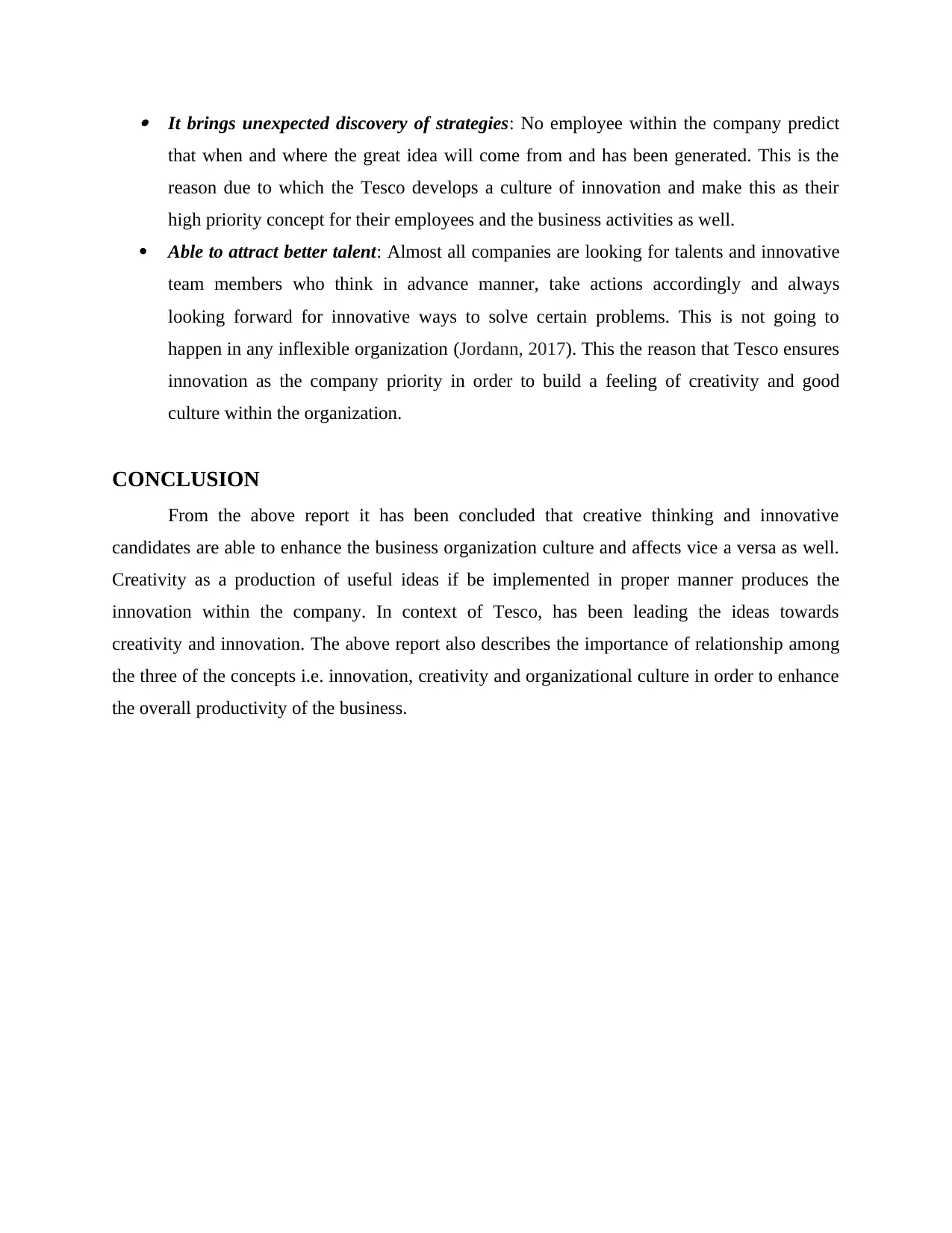
It brings unexpected discovery of strategies: No employee within the company predict
that when and where the great idea will come from and has been generated. This is the
reason due to which the Tesco develops a culture of innovation and make this as their
high priority concept for their employees and the business activities as well.
Able to attract better talent: Almost all companies are looking for talents and innovative
team members who think in advance manner, take actions accordingly and always
looking forward for innovative ways to solve certain problems. This is not going to
happen in any inflexible organization (Jordann, 2017). This the reason that Tesco ensures
innovation as the company priority in order to build a feeling of creativity and good
culture within the organization.
CONCLUSION
From the above report it has been concluded that creative thinking and innovative
candidates are able to enhance the business organization culture and affects vice a versa as well.
Creativity as a production of useful ideas if be implemented in proper manner produces the
innovation within the company. In context of Tesco, has been leading the ideas towards
creativity and innovation. The above report also describes the importance of relationship among
the three of the concepts i.e. innovation, creativity and organizational culture in order to enhance
the overall productivity of the business.
that when and where the great idea will come from and has been generated. This is the
reason due to which the Tesco develops a culture of innovation and make this as their
high priority concept for their employees and the business activities as well.
Able to attract better talent: Almost all companies are looking for talents and innovative
team members who think in advance manner, take actions accordingly and always
looking forward for innovative ways to solve certain problems. This is not going to
happen in any inflexible organization (Jordann, 2017). This the reason that Tesco ensures
innovation as the company priority in order to build a feeling of creativity and good
culture within the organization.
CONCLUSION
From the above report it has been concluded that creative thinking and innovative
candidates are able to enhance the business organization culture and affects vice a versa as well.
Creativity as a production of useful ideas if be implemented in proper manner produces the
innovation within the company. In context of Tesco, has been leading the ideas towards
creativity and innovation. The above report also describes the importance of relationship among
the three of the concepts i.e. innovation, creativity and organizational culture in order to enhance
the overall productivity of the business.
Paraphrase This Document
Need a fresh take? Get an instant paraphrase of this document with our AI Paraphraser
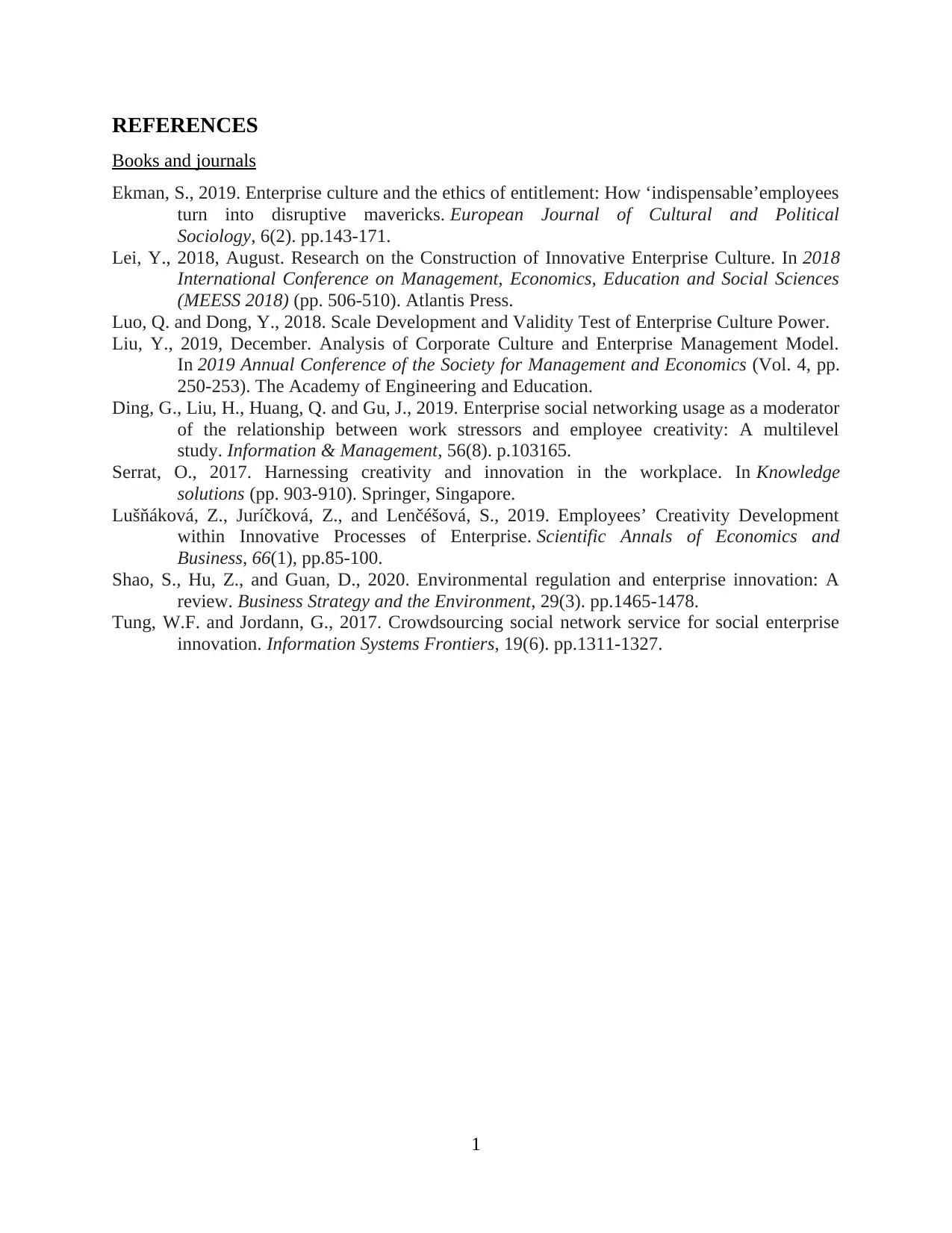
REFERENCES
Books and journals
Ekman, S., 2019. Enterprise culture and the ethics of entitlement: How ‘indispensable’employees
turn into disruptive mavericks. European Journal of Cultural and Political
Sociology, 6(2). pp.143-171.
Lei, Y., 2018, August. Research on the Construction of Innovative Enterprise Culture. In 2018
International Conference on Management, Economics, Education and Social Sciences
(MEESS 2018) (pp. 506-510). Atlantis Press.
Luo, Q. and Dong, Y., 2018. Scale Development and Validity Test of Enterprise Culture Power.
Liu, Y., 2019, December. Analysis of Corporate Culture and Enterprise Management Model.
In 2019 Annual Conference of the Society for Management and Economics (Vol. 4, pp.
250-253). The Academy of Engineering and Education.
Ding, G., Liu, H., Huang, Q. and Gu, J., 2019. Enterprise social networking usage as a moderator
of the relationship between work stressors and employee creativity: A multilevel
study. Information & Management, 56(8). p.103165.
Serrat, O., 2017. Harnessing creativity and innovation in the workplace. In Knowledge
solutions (pp. 903-910). Springer, Singapore.
Lušňáková, Z., Juríčková, Z., and Lenčéšová, S., 2019. Employees’ Creativity Development
within Innovative Processes of Enterprise. Scientific Annals of Economics and
Business, 66(1), pp.85-100.
Shao, S., Hu, Z., and Guan, D., 2020. Environmental regulation and enterprise innovation: A
review. Business Strategy and the Environment, 29(3). pp.1465-1478.
Tung, W.F. and Jordann, G., 2017. Crowdsourcing social network service for social enterprise
innovation. Information Systems Frontiers, 19(6). pp.1311-1327.
1
Books and journals
Ekman, S., 2019. Enterprise culture and the ethics of entitlement: How ‘indispensable’employees
turn into disruptive mavericks. European Journal of Cultural and Political
Sociology, 6(2). pp.143-171.
Lei, Y., 2018, August. Research on the Construction of Innovative Enterprise Culture. In 2018
International Conference on Management, Economics, Education and Social Sciences
(MEESS 2018) (pp. 506-510). Atlantis Press.
Luo, Q. and Dong, Y., 2018. Scale Development and Validity Test of Enterprise Culture Power.
Liu, Y., 2019, December. Analysis of Corporate Culture and Enterprise Management Model.
In 2019 Annual Conference of the Society for Management and Economics (Vol. 4, pp.
250-253). The Academy of Engineering and Education.
Ding, G., Liu, H., Huang, Q. and Gu, J., 2019. Enterprise social networking usage as a moderator
of the relationship between work stressors and employee creativity: A multilevel
study. Information & Management, 56(8). p.103165.
Serrat, O., 2017. Harnessing creativity and innovation in the workplace. In Knowledge
solutions (pp. 903-910). Springer, Singapore.
Lušňáková, Z., Juríčková, Z., and Lenčéšová, S., 2019. Employees’ Creativity Development
within Innovative Processes of Enterprise. Scientific Annals of Economics and
Business, 66(1), pp.85-100.
Shao, S., Hu, Z., and Guan, D., 2020. Environmental regulation and enterprise innovation: A
review. Business Strategy and the Environment, 29(3). pp.1465-1478.
Tung, W.F. and Jordann, G., 2017. Crowdsourcing social network service for social enterprise
innovation. Information Systems Frontiers, 19(6). pp.1311-1327.
1
1 out of 8
Related Documents
Your All-in-One AI-Powered Toolkit for Academic Success.
+13062052269
info@desklib.com
Available 24*7 on WhatsApp / Email
![[object Object]](/_next/static/media/star-bottom.7253800d.svg)
Unlock your academic potential
Copyright © 2020–2025 A2Z Services. All Rights Reserved. Developed and managed by ZUCOL.





